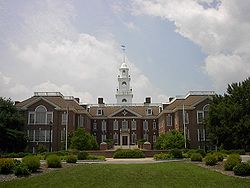Delaware General Assembly | |
|---|---|
 | |
| Type | |
| Type | |
| Houses | Senate House of Representatives |
| Leadership | |
Senate President pro tempore | |
House Speaker | |
| Structure | |
| Seats | 62 |
 | |
Senate political groups |
|
 | |
House of Representatives political groups |
|
| Elections | |
Last Senate election | November 5, 2024 |
Last House of Representatives election | November 5, 2024 |
Next Senate election | November 3, 2026 |
Next House of Representatives election | November 3, 2026 |
| Meeting place | |
 | |
| Legislative Hall Dover | |
| Website | |
| Delaware General Assembly | |
| Constitution | |
| Constitution of Delaware | |
The Delaware General Assembly is the legislature of the U.S. state of Delaware. It is a bicameral legislature composed of the Delaware Senate with 21 senators and the Delaware House of Representatives with 41 representatives. It meets at Legislative Hall in Dover, convening on the second Tuesday of January of odd-numbered years, with a second session of the same Assembly convening likewise in even-numbered years. Normally the sessions are required to adjourn by the last day of June of the same calendar year. However, the Governor can call a special session of the legislature at any time.
Contents
Members are elected from single-member districts, all apportioned to roughly equal populations after each decennial Census. Elections are held on the Tuesday after the first Monday in November and approximately half of the Senate is elected every two years to a four-year term, and the entire House of Representatives is elected every two years to a two-year term. Vacancies are filled through special elections. There are no term limits for either chamber.
With 62 seats, the Delaware General Assembly is the second-smallest bicameral state legislature in the United States – ahead of Alaska (60 seats) and behind Nevada (63).